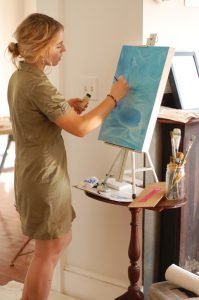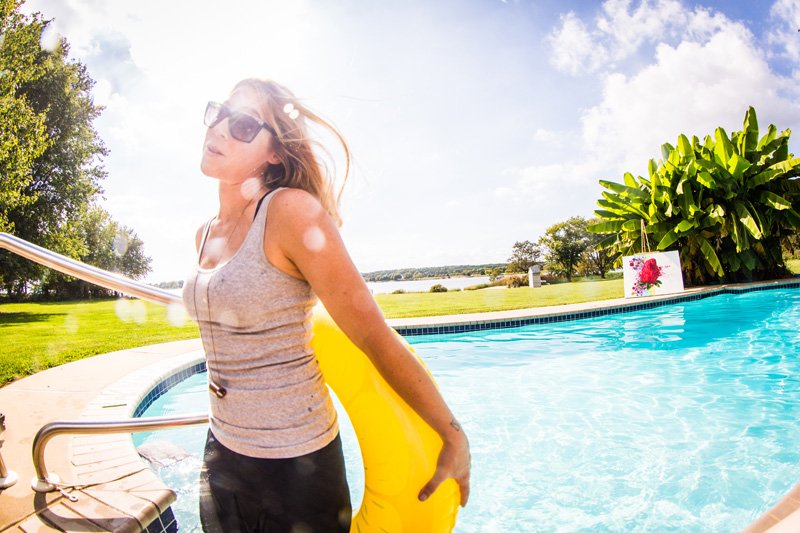+ By Katherine Matuszak + Photography By Mary Ella Jourdak
When Stephanie Claire Baker was in art school, her professors stressed the importance of a cohesive portfolio. Unification in your body of work ensured that it would be recognizable and therefore marketable. Now nearly 10 years out of art school and working as an artist full-time, Baker admits she’s always struggled with that particular advice. “I like so many different things,” she says. “I’d never be able to be sworn to just one.”
In a high-speed world where digital media is consumed at a faster rate than ever, traditional art forms struggle to maintain relevance. When Baker first began freelancing after graduating from Savannah College of Art and Design in 2008, she learned those difficulties firsthand. “It’s hard to self-motivate and keep on pursuing,” she says. “As a freelance artist, you are your own business, and I don’t know how well that’s stressed to students.” Luckily, she’s always loved a challenge.
Maintaining an open mind while expanding her portfolio meant finding work on a variety of projects beyond painting canvases. Among many other wonderfully unusual experiences, Baker worked at a woodshop, cut and assembled glass pieces for a lengthy mosaic project, and worked with a small construction team, changing the plumbing system of a government building from steel to copper. She later used her copper cutting and polishing skills in personal art projects—one of many ways these seemingly unrelated jobs foster skills she eventually uses in her artwork.
“One thing I’ve come to have a strong understanding of, as a painter in the modern era, is to be highly adaptable and very willing to do a variety of work under the broadest spectrum of arts, and [to be] working with my hands,” Baker explains. She currently paints furniture, doing custom paint jobs and restorations. She also works on more traditional paintings, exploring whatever subjects resonate with her life experiences. Sometimes this involves detailed paintings of exploding strawberries and pears, while other days she focuses on her most challenging ongoing project—her water series. In this effort, Baker creates vivid portrayals of her earliest visual memory, what she calls her original visual influence.
“Seeing the way clear water looks . . . in a sink, a bathtub, or a pool, I just remember being entranced by it. As I’ve gotten older, I feel I have to dissect it, but that dissection can be tedious and tough,” she says. “Crisply portraying the caustic network, the water’s refractions, really nailing down the chaos . . . that’s my go-to challenge.”
Baker’s love of ambitious art projects began at an early age. She spent two years, from ages 10 to 12, building a massive magazine collage that she still has, citing it as an important learning experience. She collected her grandfather’s subscription copies of Time and Life magazines, dutifully read the articles, and then cut them up and carefully arranged the cuttings. Each time she ran out of room, she taped more paper to the piece to expand it further. The project was considered finished when it became so large she couldn’t jump over it anymore.
 When she was 15 years old, an art teacher took Baker and her class on a field trip to the American Visionary Arts Museum (AVAM) in Baltimore, the largest folk art museum in the United States. Having lived in a rural hometown without an abundance of art or cultural experiences, Baker says that trip opened her eyes to what being an artist could really mean. “The gift shop alone blew my mind,” she says, referencing the museum’s focus on outsider art. “I saw a cabinet adorned with bottle caps, corks, things that could be kind of kitschy, and that’s the point. I just thought, ‘You can glue pounds of baubles to things, and it’s glorious-looking.’ The core concept of the museum is that no one can be a trained visual artist.” Baker’s love for the museum exudes as she reminisces on that trip. In 2013, she volunteered to make a sidewalk mural for AVAM commemorating the writing of the national anthem. The project led to her working there for several years.
When she was 15 years old, an art teacher took Baker and her class on a field trip to the American Visionary Arts Museum (AVAM) in Baltimore, the largest folk art museum in the United States. Having lived in a rural hometown without an abundance of art or cultural experiences, Baker says that trip opened her eyes to what being an artist could really mean. “The gift shop alone blew my mind,” she says, referencing the museum’s focus on outsider art. “I saw a cabinet adorned with bottle caps, corks, things that could be kind of kitschy, and that’s the point. I just thought, ‘You can glue pounds of baubles to things, and it’s glorious-looking.’ The core concept of the museum is that no one can be a trained visual artist.” Baker’s love for the museum exudes as she reminisces on that trip. In 2013, she volunteered to make a sidewalk mural for AVAM commemorating the writing of the national anthem. The project led to her working there for several years.
Baker finds joy in the challenges her art creates, especially when she sees its effect on others. She recalls a time she hung paintings in Metropolitan Kitchen & Lounge, which opens its space up to visual artists. The day she planned to pull a particular painting, she got a call from a woman who was interested in buying it. When they met, the woman told Baker she was so excited about the piece that she’d been having dreams about it. “That’s what I want to hear forever and ever,” Baker says with a smile in her voice.
She is currently working on new pieces in her water project that explore fear and are inspired by a story her father told her about his time in the merchant marines. She hopes to examine the way fear can paralyze us and prevent us from doing even the simplest things.
She also recognizes the fear involved in pursuing her career. “It’s scary, but . . . what’s to be scared of?” she asks. Baker mentions a documentary on people who fish at the end of Victoria Falls, a massive waterfall teeming with crocodiles. “Even if I had to do that, I’d rise to the occasion, somehow. I try to cultivate fearlessness, which is its own art. I can always adapt into something else. I’m trying to stamp out fear completely.” █













